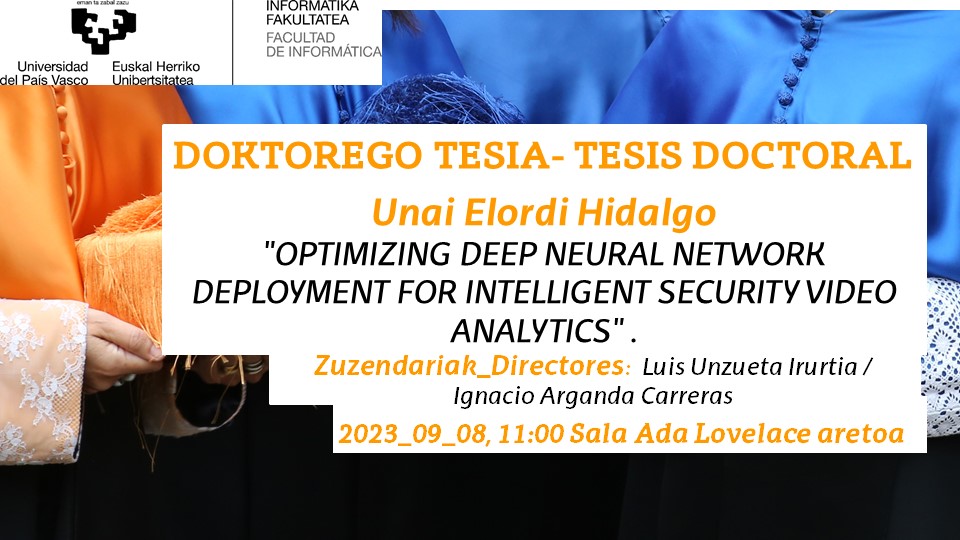08-09-2023 ;11:00 DOCTORAL THESIS DEFENCE UNAI ELORDI HIDALGO
First publication date: 05/09/2023

Unai Elordi Hidalgo: "OPTIMIZING DEEP NEURAL NETWORK DEPLOYMENT FOR INTELLIGENT SECURITY VIDEO ANALYTICS" .
Zuzendariak_Directores: Luis Unzueta Irurtia / Ignacio Arganda Carreras
2023_09_08, 11:00 Sala Ada Lovelace aretoa
Abstract:
"Intelligent Security Video Analytics (ISVA) powered by Artificial Intelligence (AI) offer a solution to the limitations of traditional video surveillance, limitations such as manual monitoring inefficiencies and the inability to detect security threats in real-time. Deep Neural Networks (DNNs) have proven to be highly effective in video analytics, but their deployment in current intelligent system infrastructures is challenging due to their high computational power requirements. These networks are complex inter-connected neuron graphs with a large number of parameters and arithmetic operations, resulting in processing bottlenecks. Moreover, DNN-based vision applications involve processing pipelines with multiple DNN inference tasks and data pre- and post-processing operations, leading to increased processing overhead. Although several DNN optimization techniques have been proposed, new end-to-end pipeline optimization strategies are necessary as more complex DNN-based intelligent systems are developed.
To overcome these DNN computing limitations, new AI accelerators have emerged (Google's TPU, Intel's VPU, etc. that we can generically call "xPU", and also improved CPU, GPU and FPGA architectures), designed to be energy-efficient and to enhance the performance of DNN inference. However, deploying these devices effectively requires significant expertise and analysis. Additionally, the cost of these devices may not be justified unless they are utilized efficiently.
ISVA systems can be integrated into heterogeneous, decentralized, and distributed computing platforms, such as cloud or fog environments, and offline edge devices or in the Internet of Things (IoT) context. These infrastructures require a comprehensive analysis of the optimal deployment strategy due to their diversity, including multiple devices, application architectures, and runtimes. Unfortunately, these runtimes and devices are not designed for DNN inference, and there is a lack of support for AI accelerators in such diverse computing platforms.
This thesis aims to enhance the deployment of DNN-based vision applications in intelligent system infrastructures through the latest advances in DNN optimization techniques and tailored deployment strategies for Computer Vision (CV). The research aims to improve the efficiency and effectiveness of ISVA, enabling seamless integration into intelligent system infrastructures and paving the way for smarter IoT systems. By optimizing DNN and CV techniques and deployment strategies, the thesis seeks to overcome the challenges associated with the computational requirements of DNN-based vision applications.
To achieve the objectives of enhancing the deployment of DNN-based vision applications in intelligent system infrastructures, this study proposes different deployment strategies of DNNs for ISVA in different environments. These environments include (1) serverless cloud environments for large-scale and highly variable computing workloads, (2) heterogeneous IoT platforms, and (3) edge devices with low-computational resources and demanding workloads.
The first strategy provides a comprehensive performance evaluation of DNN inference in serverless cloud environments and multi-DNN deployment strategies in the context of video surveillance. The second strategy analyzes the optimal deployment in heterogeneous IoT environments of multi-DNN-based face recognition algorithms including face quality assessment, anti-spoofing, face verification, and managing secure biometric data. Finally, the third strategy optimizes an end-to-end multi-DNN deployment pipeline for aircraft cabin readiness verification.
Their outcomes reveal that the deployment of DNN-based solutions for ISVA can benefit from on-site benchmarking and knowledge-based procedures to leverage the computing capabilities of the targeted computing platforms in each use case."


